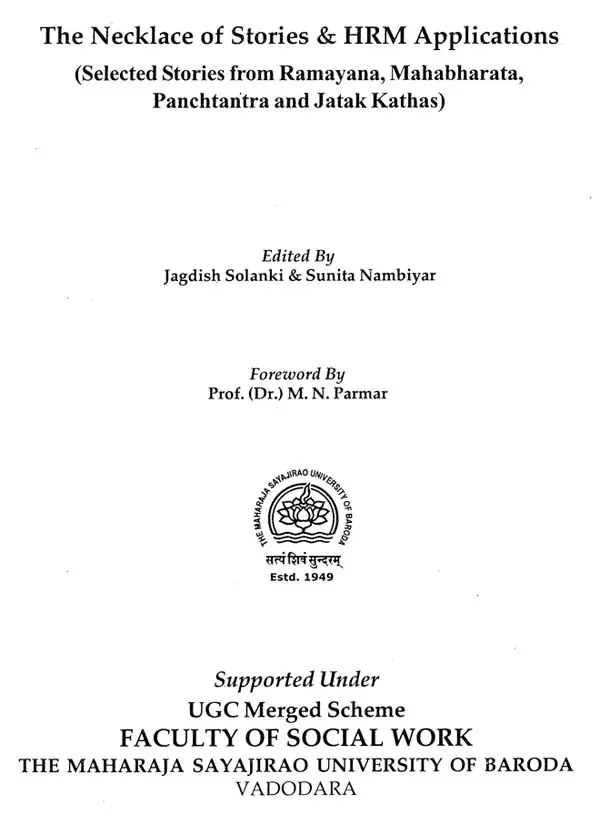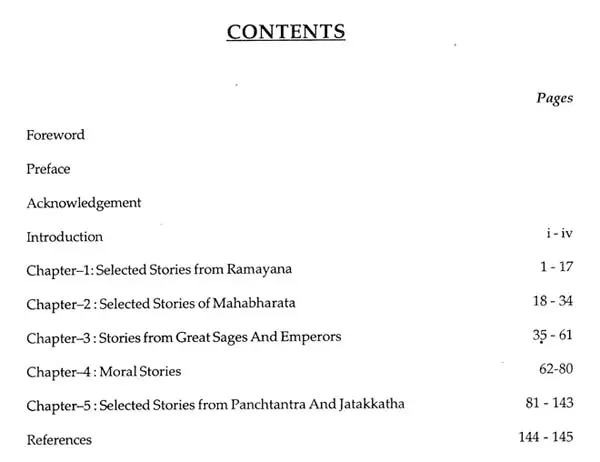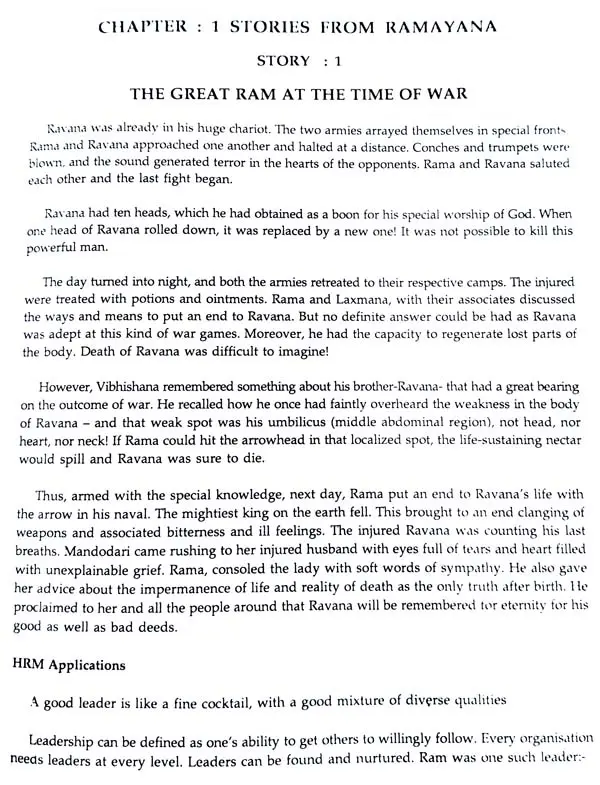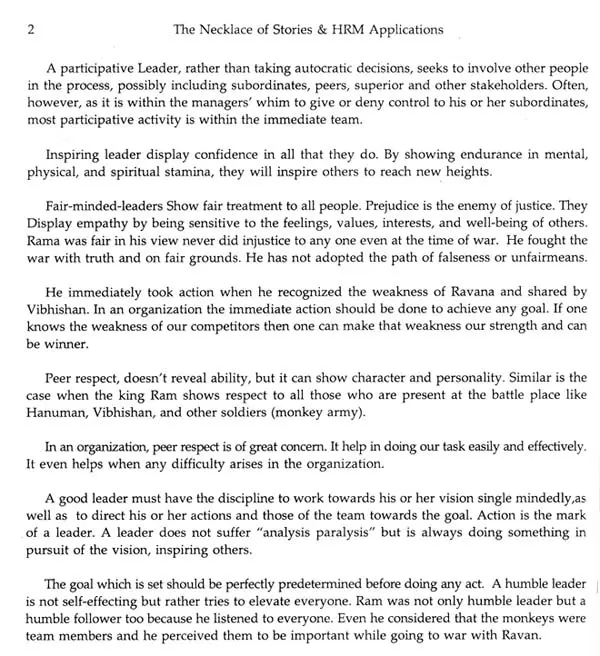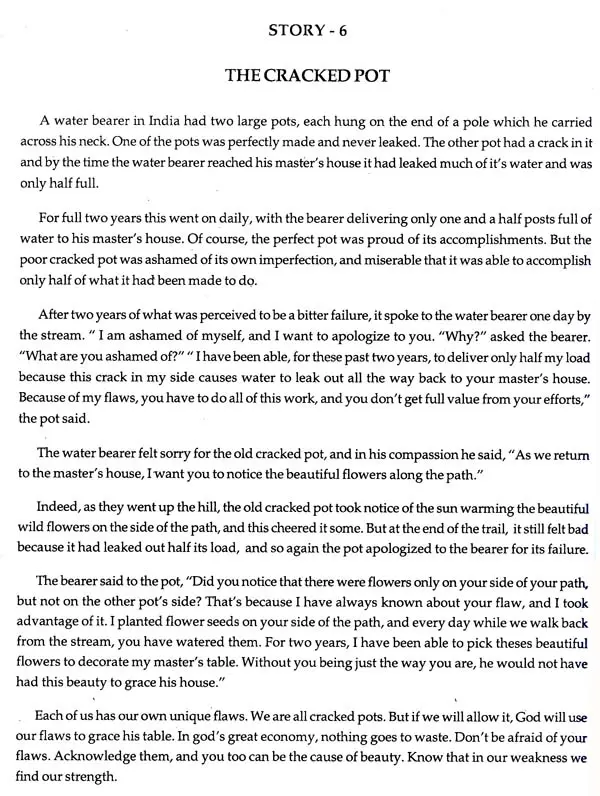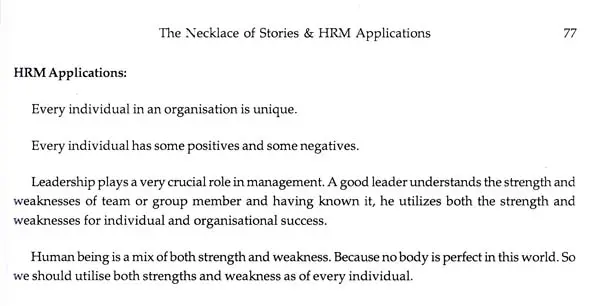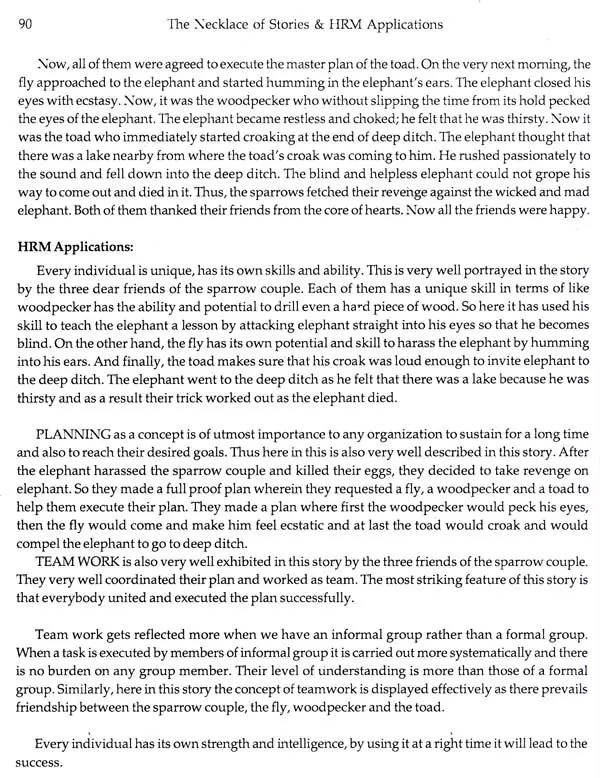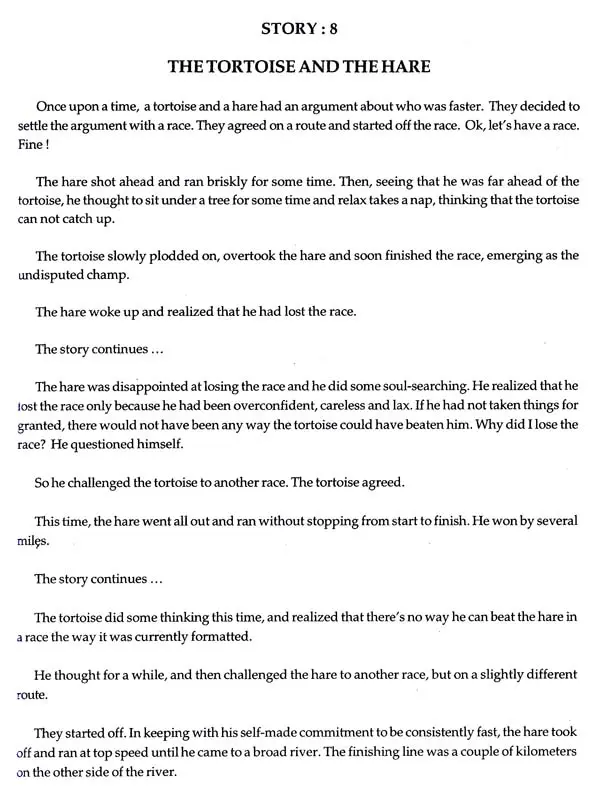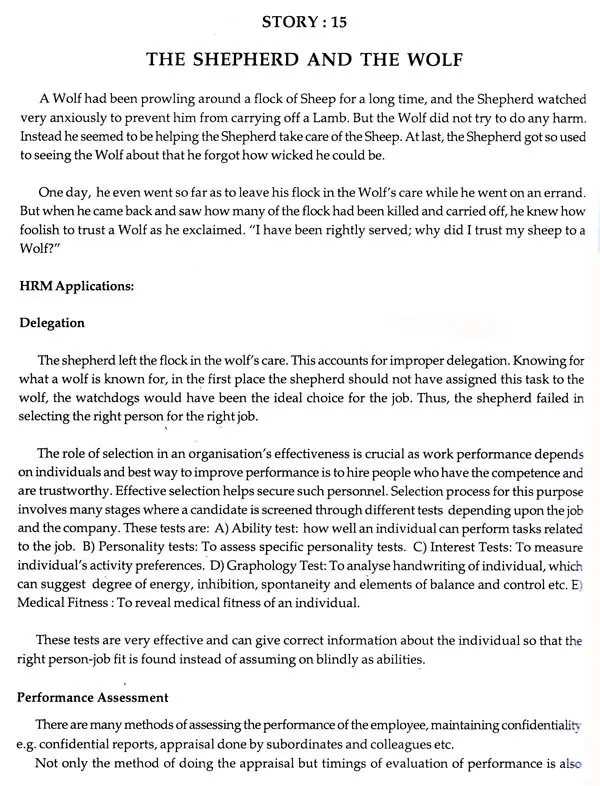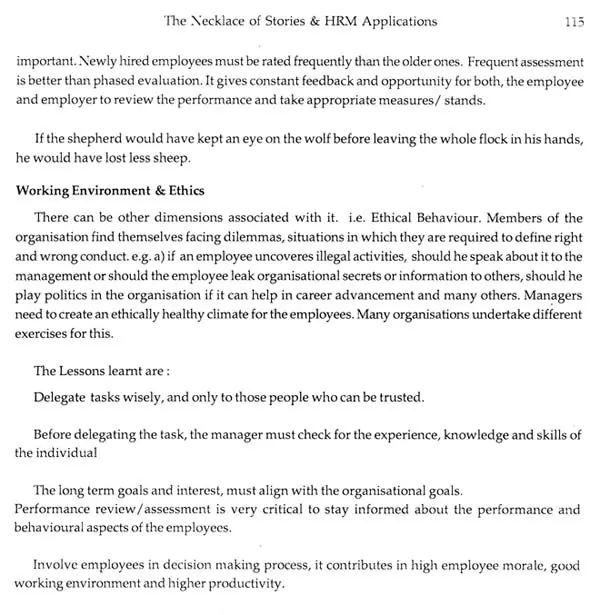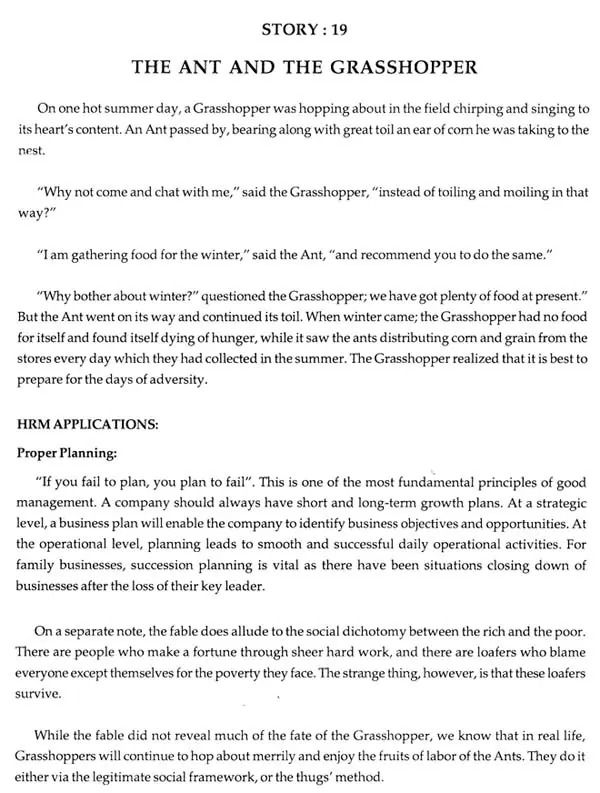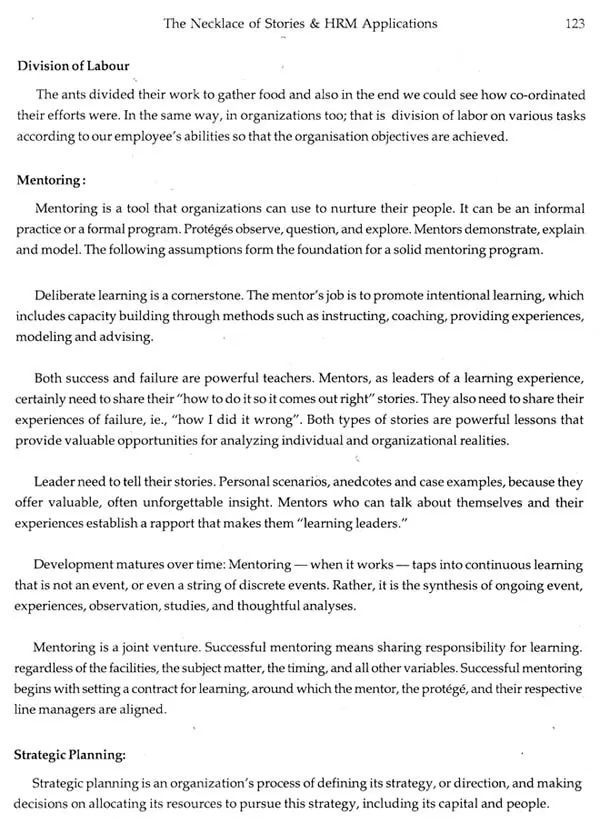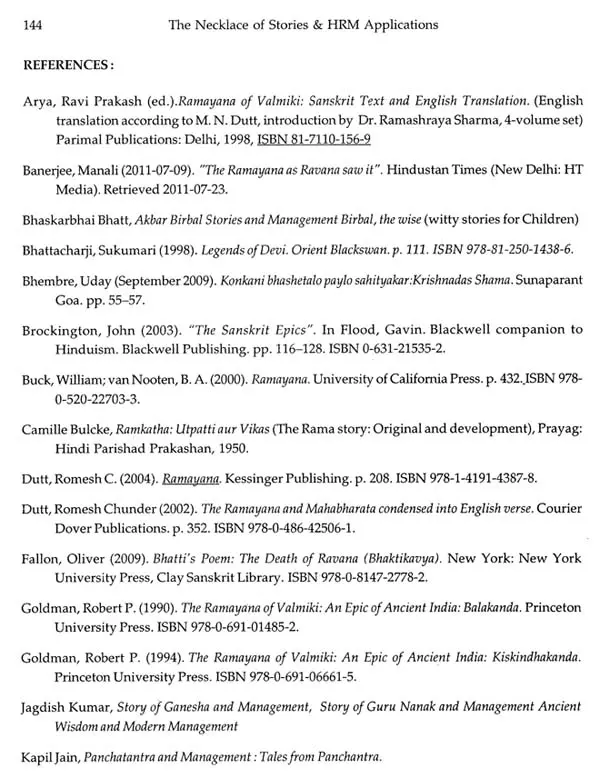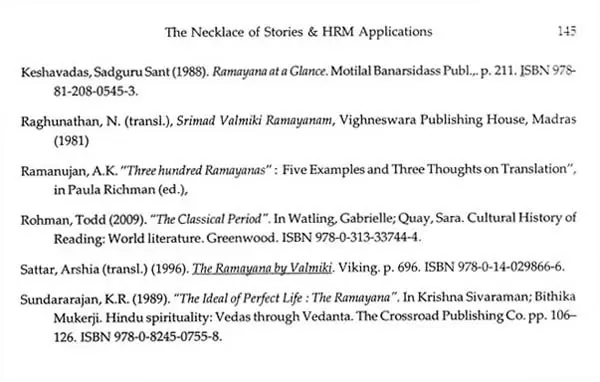
The Necklace of Stories & HRM Applications (Selected Stories From Ramayana, Mahabharata, Panchatantra And Jatak Kathas)
Book Specification
| Item Code: | UAQ427 |
| Author: | Jagdish Solanki And Sunita Nambiyar |
| Publisher: | The Mahraja Siyajirao University of Barodra |
| Language: | English |
| Edition: | 2018 |
| ISBN: | 9788193129883 |
| Pages: | 145 |
| Cover: | PAPERBACK |
| Other Details | 9.50 X 7.40 inch |
| Weight | 310 gm |
Book Description
To write the foreword for this book is a privilege, to which one is proud of. To me, this is one such moment of privilege. Each year, we have "tutorials" as an integral part of Human Resource Management Programme in The Faculty of Social Work, The Maharaja Sayajirao University, Baroda, where the faculty members take up a theme on which management students are given the opportunity to undertake an academic exercise.
As our academic world looks to the advent of next millemium, the risk and allround metamorphosis in the teaching-learning processes of the universities is indeed becoming a challenge. In order to cope up the changes, we need to be innovative in imparting of knowledge, skills and values, which find much acceptance and approval in the young Indian minds. In this contexts, In the year 2010 my colleagues Dr. Jagdish Solanki, Dr. Sunita Nambiyar and Mrs. Amita Jaspal have identified the theme of the tutorial on "Management stories based on Ramayan Mahabharat, Panchatantra, Jatak Tales and from lives of Lord Buddha, Mahavirswami, Acharya Chankya, Swami Samarth Ramdas and many such. As part of this academic exercise HRM-Students have collected and presented stories with management application. I do hope that students will appreciate the efforts of my colleagues as innovative academic experiment to unfold their learning potentials.
This book blends the truth and wisdom exponded through Indian religious and cultural heritage and gives many insights in them. The title itself creates curiosity amongst the readers. This book is special in its presentation where narrations are revealing the real life instances in form of stories which touch the head and heart of the readers. Besides, this book can be read from any chapter or page, yet, it will stimulate the readers.
I congratulate my colleagues and students on pursuing this innovative academic work, which I am sure, will inspire many.
Prof. M. N. Parmar
Dean & Head
There is a Jewish question what is truer than truth? The Answer is The Story.
The Art of storytelling is perhaps as old as the human existence. It has evolved with the growth of the mankind as a social creature and has taken different modes of expression. A story has the dual of entertaining people and giving them some thoughts to ponder upon. Thus, it has two parts the narrative and the ideas that it wants to convey. The first being overt, the second covert. As purpose o children, we are more interested in the narration of the story. As adults or as individuals in work organizations, we are interested by the ideas or message that stories convey.
It is already becoming clear that a chapter which has a western beginning in business management will have to have an Indian ending when the world adopts rich thoughts of Indian ethos and wisdom, if it is not to end in the self-destruction of the human race. At the supremely dangerous moment in history the only way of salvation is the Indian way."-Amold Toynbee, British Historian & Philosopher-(1889-1975). The essence of Indian wisdom cannot be more emphasised.
The aim of this academic pursuit is to capture the wisdom of the ages and to make it relevant for these times and to help the HR managers to come up with innovative methodologies to help organization to harness their latent potential and channel their energies towards cultivation and sharpening of multiple dimensions of human competencies. This academic work addresses the theme of management from ancient Indian cultural perspective and provides an effective approach to make future managers more socially concerned, compassionate, liberal, inclusive, ethical, and humane Education must address the issue of character formation along with developing the full potential of human beings besides revealing the great and hidden values of life which lie beyond the obvious, phenomenal phase of existence, a broader vision of life and insight into the unfathomable ocean of wisdom. It must also reveal to the young generation the possibilities of attaining values in life much greater and higher than those found on the level of relative existence.
The Ramayana and the Mahabharata are great epics from where qualities of leadership, readiness to learn and such others necessary in today's competitive environment comes out evidently, here the stories are reproduced from various sources like Panchatantra, Jatak Tales and great epics like the Mahabharat, Ramayana etc.
Most of the Management applications written and explained are written by the HR Management students. Nevertheless they are read, revised and edited. However, we solely take responsibility for the limitations if any, for the same.
This volume is the journey of childhood revisited, that we enjoyed, cherished and the enthused in giving the best to the readers which culminated into this publication. Readers may find that most of the stories are those which one has heard from grandparents, parents, or from Amar Chitra Kathas or seen them in television as serials, However, what is added here is the flavor of management concepts and its applications. We are sure that readers will revisit their childhood and will also think on concepts which are related to at the end of the stories. This book will surely help management students and practitioners in realizing and appreciating the rich culture of India and bring out the spirit of the stories while dealing with individuals and groups in work organizations. The young professionals of the country when instilled with a strong value system along with knowledge and strength, will surely prove to be a demographic dividend.
We sincerely wish readers to enjoy and cherish reading this book
Editors:
Prof. (Dr.) Jagdish Solanki & Prof (Dr.) Sunita Nambiyar
"If I were to look over the whole world to find out the country most richly endowed all the wealth power and beauty that nature can bestow- in some part a very paradise on earth-I should point out Alodia 111 were asked under which sky, the human mind has most fully developed choicest gifts, has most deeply pondered on the greatest problems of life, and has found solutions of some of them which well deserve the attention even of those who have studied Plato and Kant-I should point to India And if I were to ask myself from what literature we have in Europe, we who have been nurtured almost exclusively on the thoughts of Greeks and Romans, and of one Semitic race, the Jewish, may draw the corrective which is most wanted in order to make our inner life more perfect, more comprehensive, more universal, in fact more truly human, a life, not for this life only, but a transfigured and eternal life-again, I should point to India... Such are the narrations revealed by FMax Muller, (In India: What Can It Teach Us?)
This enables us to think and feel for religo-cultural heritage, wisdom and eternality of human existence influencing each walk of life including management since time immemorial. Some such Indian scriptures are depicted prominently in volumes of Ramayan, Mahabharat, Panchtantra, Jatak Tales and in major contributions of the Avtars, sages and achieverers like Buddhas, Mahavir, Chanakya, etc:
The Ramayana tells about life in India around 1000 BC and offers models in dharma. The hero, Rama, lived his whole life by the rules of dharma; in fact, that is why Indians consider him a hero. The original Ramayana was a 24,000 couplet long epic poem attributed to the Sanskrit poet Valmiki Oral versions of Rama's story circulated for centuries, and the epic was probably first written down sometime around the start of the Common Era. It has since been told, retold, translated and transcribed throughout South and Southeast Asia, and the Ramayana continues to be performed in dance, drama, puppet shows, songs and movies all across Asia.
The Mahabharata (composed between 300 BC and 300 AD) has the honor of being the longest epic in world literature, 100,000, 2-line stanzas (although the most recent critical edition edits this down to about 88,000), making it eight times as long as Homer's Iliad and Odyssey together, and over 3 times as long as the Bible (Chaitanya vii). In other words, the Mahabharata resembles a long journey with many side roads and detours. It is said that "Whatever is here is found elsewhere. But whatever is not here is nowhere else."The name means "great [story of the] Bharatas," Bharata was an early ancestor of both the Pandavas and Kauravas who fought against each other in a great war, but the word is also used generically for the Indian race, so the Mahabharata sometimes is referred to as "the great story of India."
